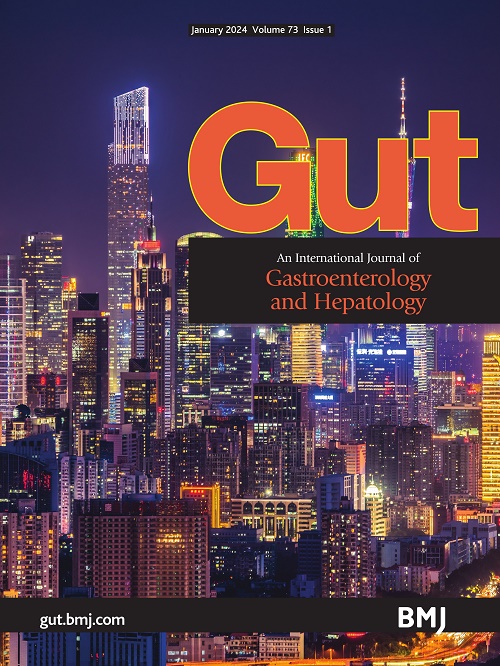阿司匹林可以降低糖尿病患者患胰腺癌和癌症相关死亡率的风险
IF 23
1区 医学
Q1 GASTROENTEROLOGY & HEPATOLOGY
引用次数: 0
摘要
背景2型糖尿病(T2DM)患者患胰腺癌(PC)的风险较高。虽然阿司匹林对消化系统癌症有化学预防作用,但其对2型糖尿病患者PC的影响尚不清楚。方法:本回顾性队列研究从2001年至2015年香港地区的医疗保健登记中心中确定了新诊断的成年T2DM患者。排除标准为有PC病史、胰腺囊肿、IgG4疾病或胰腺切除术。为了解决PC和T2DM之间的反向因果关系,我们排除了在1年内诊断为PC的T2DM患者。我们还排除了观察时间少于1年的患者。主要结局是PC,次要结局是PC相关和全因死亡率。阿司匹林的使用作为时变变量(≥180天/年)来解决不朽时间偏差,并采用多变量Cox回归模型得出调整后HR (aHR)。二级分析采用倾向-得分(PS)匹配。结果343 966例新诊断T2DM患者(中位随访时间:10.5年;IQR: 7.7 ~ 14.5年),1224年(0.36%)发展为PC。51 151例(14.9%)死于各种原因,787例(0.2%)死于PC。阿司匹林的使用与两种时间依赖性的较低的PC风险相关(aHR: 0.58;95% CI 0.49 ~ 0.69)和PS匹配分析(aHR: 0.61;95% CI 0.48 ~ 0.77)。与阿司匹林使用剂量和持续时间的增加呈负相关(P趋势<0.001)。阿司匹林还与较低的pc相关死亡风险相关(aHR: 0.43;95% CI 0.34 ~ 0.53)和全因死亡率(aHR: 0.78;95% CI 0.76 ~ 0.80)。结论阿司匹林可能是降低2型糖尿病患者PC风险的一种预防策略。需要进一步的研究来验证研究结果。数据可能会从第三方获得,并且不会公开提供。本研究的数据由香港医院管理局提供。限制适用于这些数据的可用性,这些数据是根据许可使用的。本文章由计算机程序翻译,如有差异,请以英文原文为准。
Aspirin is associated with lower risk of pancreatic cancer and cancer-related mortality in patients with diabetes mellitus
Background Patients with type 2 diabetes mellitus (T2DM) have higher pancreatic cancer (PC) risk. While aspirin has chemopreventive effects on digestive cancers, its effect on PC among patients with T2DM is unclear. Methods This retrospective cohort study identified newly diagnosed adult patients with T2DM in Hong Kong between 2001 and 2015 from a territory-wide healthcare registry. Exclusion criteria were history of PC, pancreatic cyst, IgG4 disease, or pancreatectomy. To address reverse causality between PC and T2DM, we excluded patients with PC diagnosed within 1 year of T2DM. We also excluded patients with less than 1 year of observation. Primary outcome was PC, and secondary outcomes were PC-related and all-cause mortality. Aspirin use was treated as time-varying variable (≥180 day-use/year) to address immortal-time bias, and multivariable Cox regression model was employed to derive adjusted HR (aHR). Propensity-score (PS) matching was used as secondary analysis. Results Among 343 966 newly diagnosed patients with T2DM (median follow-up: 10.5 years; IQR: 7.7–14.5 years), 1224 (0.36%) developed PC. There were 51 151 (14.9%) deaths from any cause, and 787 (0.2%) died from PC. Aspirin use was associated with lower PC risk in both time-dependent (aHR: 0.58; 95% CI 0.49 to 0.69) and PS matching analysis (aHR: 0.61; 95% CI 0.48 to 0.77). An inverse relationship was observed with increasing dose and duration of aspirin use ( P trend<0.001). Aspirin was also associated with a lower risk of PC-related mortality (aHR: 0.43; 95% CI 0.34 to 0.53) and all-cause mortality (aHR: 0.78; 95% CI 0.76 to 0.80). Conclusion Aspirin use may be an oncopreventive strategy to reduce PC risk in patients with T2DM. Further studies are warranted to validate the study findings. Data may be obtained from a third party and are not publicly available. The data of this study were provided by the Hong Kong Hospital Authority. Restrictions apply to the availability of these data, which were used under license.
求助全文
通过发布文献求助,成功后即可免费获取论文全文。
去求助
来源期刊

Gut
医学-胃肠肝病学
CiteScore
45.70
自引率
2.40%
发文量
284
审稿时长
1.5 months
期刊介绍:
Gut is a renowned international journal specializing in gastroenterology and hepatology, known for its high-quality clinical research covering the alimentary tract, liver, biliary tree, and pancreas. It offers authoritative and current coverage across all aspects of gastroenterology and hepatology, featuring articles on emerging disease mechanisms and innovative diagnostic and therapeutic approaches authored by leading experts.
As the flagship journal of BMJ's gastroenterology portfolio, Gut is accompanied by two companion journals: Frontline Gastroenterology, focusing on education and practice-oriented papers, and BMJ Open Gastroenterology for open access original research.
 求助内容:
求助内容: 应助结果提醒方式:
应助结果提醒方式:


